
Notodontidae is a family of moths with approximately 3,800 known species. The family was described by James Francis Stephens in 1829. Moths of this family are found in all parts of the world, but they are most concentrated in tropical areas, especially in the New World.
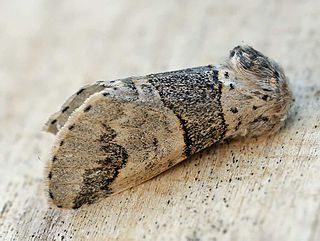
The poplar kitten is a species of moth in the family Notodontidae. The species was first described by Nikolaus Joseph Brahm in 1787. They are found throughout Europe and in North Africa, Mongolia, Kazakhstan and Xinjiang.

Choristoneura occidentalis is a species of moth of the family Tortricidae. It is found in the Democratic Republic of Congo, South Africa, Tanzania and Gambia.

Furcula furcula, the sallow kitten, is a moth from the family Notodontidae. It was first described by the Swedish entomologist Carl Alexander Clerck in 1759 from a specimen found in Sweden.

Melitaea didyma, the spotted fritillary or red-band fritillary, is a Palearctic butterfly of the family Nymphalidae.
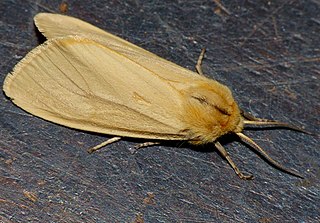
Saenura is a genus of moth in the subfamily Arctiinae. It contains only one species, Saenura flava, which can be found in southern Africa.
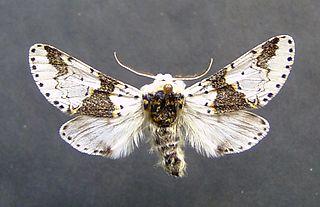
Furcula bicuspis, the alder kitten, is a moth of the family Notodontidae. The species was first described by Moritz Balthasar Borkhausen in 1790. It is found in most of the Palearctic realm.

Catocala chelidonia is a moth of the family Erebidae. It is found from Arizona and Utah to California.

Catocala connubialis, the connubial underwing, is a moth of the family Erebidae. The species was first described by Achille Guenée in 1852. It is found in North America from Ontario to Prince Edward Island, south to Florida and west to Texas, Oklahoma, and Missouri.

Furcula is a genus of moths of the family Notodontidae. The genus was described by Jean-Baptiste Lamarck in 1816.

Furcula borealis, the white furcula moth, is a moth of the family Notodontidae. It is found from New Hampshire to Texas and Florida, as well as in Colorado and South Dakota.

Furcula cinerea, the gray furcula moth, is a species of moth in the family Notodontidae. It was first described by Francis Walker in 1865. It is found in the United States, southern Canada and the Northwest Territories.
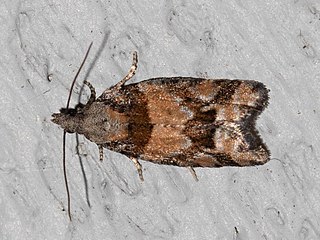
Epinotia radicana, the red-striped needleworm moth, is a species of moth of the family Tortricidae. It is found in western Canada, including British Columbia and Alberta.
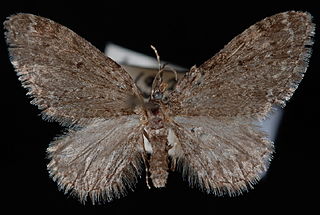
Eupithecia annulata, the larch pug moth, is a moth in the family Geometridae. The species was first described by George Duryea Hulst in 1896. It is found in North America from British Columbia north to the Yukon, east to Newfoundland and Labrador and south to California and Colorado.
Argyrotaenia paiuteana is a species of moth of the family Tortricidae. It is found in the United States, where it has been recorded from California.
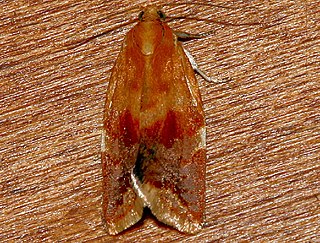
Clepsis persicana, the white triangle tortrix or the green needleworm, is a species of moth of the family Tortricidae. It is found in North America, where it has been recorded from Alaska and British Columbia to Newfoundland and south to Virginia and west to California. The habitat consists of coniferous and mixed coniferous forests.
Elophila occidentalis is a moth in the family Crambidae. It was described by William Harry Lange in 1956. It is found in the United States, where it has been recorded from California, Arizona and Nebraska.
Pandemis pyrusana, the apple pandemis or pandemis leafroller moth, is a species of moth of the family Tortricidae. The species was first described by William D. Kearfott in 1907. It is found in North America, where it has been recorded from Alberta to British Columbia, south through Idaho, Utah and Colorado and California. The habitat consists of forests with deciduous trees and shrubs.
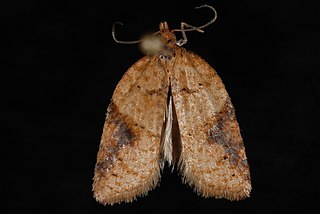
Acleris britannia, the Brittania moth, is a species of moth of the family Tortricidae. It is found in North America, where it has been recorded from Alberta, British Columbia, California, Oregon, Saskatchewan and Washington.














